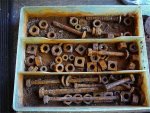And at the far end of the spectrum - how do you restore stuff that is covered with light rust?
I have tons (well, hundreds of pounds) of stuff here that Dad accumulated over 70 years that is almost, maybe barely, worth restoring for use. The tray of bolts below is typical - I occasionally put stuff like that on the grinder's wire brush wheel and clean it up to complete a project when that's simpler than driving 20 miles roundtrip for new fasteners. But that makes projects take forever.
I see articles about electrolysis. Is that practical for cleaning up multiple small objects? What about tumbling stuff in a cement mixer with sand, or walnut shells? I don't want to scatter nasty chemicals around so I haven't replaced the Naval Jelly etc that I started with.
Does anybody have a favorite method for this?
I have tons (well, hundreds of pounds) of stuff here that Dad accumulated over 70 years that is almost, maybe barely, worth restoring for use. The tray of bolts below is typical - I occasionally put stuff like that on the grinder's wire brush wheel and clean it up to complete a project when that's simpler than driving 20 miles roundtrip for new fasteners. But that makes projects take forever.
I see articles about electrolysis. Is that practical for cleaning up multiple small objects? What about tumbling stuff in a cement mixer with sand, or walnut shells? I don't want to scatter nasty chemicals around so I haven't replaced the Naval Jelly etc that I started with.
Does anybody have a favorite method for this?




